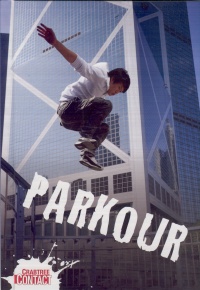| ________________
CM . . . . Volume XV Number 21. . . .June 12, 2009. 
 |
Parkour. (Crabtree Contact).
Dan Edwardes.
St. Catharines, ON: Crabtree, 2009.
32 pp., pbk. & hc., $10.95 (pbk.), $20.76 (RLB).
ISBN 978-0-7787-3842-8 (pbk.), ISBN 978-0-7787-3821-3 (RLB).
Subject Headings:
Extreme sports-Juvenile literature.
Parkour-Juvenile literature.
Grades 5-8 / Ages 10-13.
Review by Margaret Snow.
****/4
|
| |
|

excerpt:
At first glance at the title of this book, one would have difficulty not flipping through the pages wondering, 'What is PARKOUR?'
Dynamic.
Explosive.
Powerful.
Precise.
This is parkour!
Moving through the city.
Running and leaping.
Overcoming any obstacles in your path.
Never stopping. Always moving.
Parkour is a new and exciting activity. The aim of parkour is to move around an area, such as a city or park, without stopping. People who take part in parkour run, climb and jump over building and obstacles.
Originally know as "Art du Deplacement" (Art of Displacement), parkour is not just a way of movement but a philosophy of living created in France in the 1980's and 1990's. Parkour is also known as "free running." The "practitioners" are known as Yamakasi (an African term meaning "strong man, strong spirit"). The book stresses the need for training to achieve a high degree of both physical and functional strength. It details the moves, known as jumps, vaults, wall-running, arm jumps, in addition to the mental challenge involved in this physical discipline. Parkour is becoming more familiar as it has been used in magazines, music videos, commercials, TV advertisements and is especially known in cinema for the explosive opening for Casino Royale.
Author Dan Edwardes, who is from the UK, has written several manuals, articles and books on the subject of parkour. A Google search reveals that his name and videos pop up frequently. He is one of the founders of Parkour Generations, one of the largest collectives of experienced practitioners in the world. He has both the credentials and expertise on the subject. He has most effectively conveyed the information in a format which would especially entice reluctant, young, male readers to pick up the book and actually read it. I know this from experience because, when I first received the book, I had left it on my desk at school and had a real tug of war with a 12-year-old male over which one of us would read it first.
Most of the key ingredients one discusses when teaching the text features of nonfiction with children are present: table of content, the use of a variety of fonts for effect, beautiful colour photos, text boxes, labelled diagrams, glossary, web addresses for more information and an index. When sharing this book with students, one should definitely stress the red warning text boxes which alert readers to the fact that the photos are of trained professionals that have had years of training and practice (aka DON'T TRY THIS AT HOME).
The three recommended websites worked well and contained background information about this lifestyle, video clips, photos, where to find classes and more to further one's quest for information.
Highly Recommended.
Margaret Snow is a teacher-librarian and literacy teacher in a small, rural school in southwestern Ontario.

To comment on this title or this review, send mail to
cm@umanitoba.ca.
Copyright © the Manitoba Library Association. Reproduction for personal use is permitted only if this copyright notice is maintained. Any other reproduction is prohibited without permission.
NEXT REVIEW |
TABLE OF CONTENTS FOR THIS ISSUE- June 12, 2009.
AUTHORS |
TITLES |
MEDIA REVIEWS |
PROFILES |
BACK ISSUES |
SEARCH |
CMARCHIVE |
HOME |
